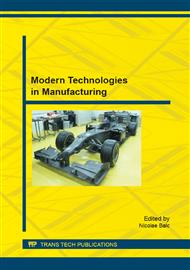p.34
p.40
p.48
p.54
p.60
p.66
p.75
p.80
p.86
Different Methods of Artificial Intelligence Used for Optimization the Turning Process
Abstract:
In this paper, we realize a comparative study between some heuristics methods applied in turning operation in order to find optimal cutting parameters. We consider five different constraints aimed to achieve minimum total cost of machining. We have chosen the Simulated Annealing (SA) – a local search method, and Weighted-Sum Genetic Algorithm (WSGA) – a non-Pareto approach of a multi-objective optimization algorithm, based on a weighted aggregation of objectives. The aggregation may be with fixed weights or with random (variable) weights. The simulations showed that, even if it produces better results than the SA, WSGA with fixed weights, does not lead to optimum results, highlighting in this way that in the formula of the cost function, some cost components may be more important than others. In addition, we extend our previous work by integrating in the software application a new optimization method: WSGA with random weights. Also, we increase the application’s flexibility by reconfiguring the graphical user interface in order to allow tuning the optimization techniques parameters.
Info:
Periodical:
Pages:
60-65
Citation:
Online since:
November 2015
Authors:
Price:
Сopyright:
© 2015 Trans Tech Publications Ltd. All Rights Reserved
Share:
Citation:


